Killing and defending against white ants
If you place plenty of termite monitors around your property, there is a very high probability that any established colonies nearby will find at least one during their constant search for additional food sources. When they find a Termite Monitor or TermiTrap (and if you check them at least every three months) you will notice they have arrived.
Once you add an easy-to-harvest Termite Bait, they take it back to feed those in the nest, most of which are going through moults. The termite bait contains an insect growth regulator that stops the moulting process, the thousands of nymphs die, decomposition gases and fungus engulfs the nest and the queen dies as well.
Finito.
Just in case they have already found a track into a building before you spread the Termite Monitors around or in case a colony misses the Termite Monitors on the way inside, you should check your home at least once, preferably twice a year. Essentially you will be looking for ‘mud’ tunnels and mud in joints and gaps and, looking and listening for hollowed out timbers. It’s your home; do it, just in case. Learn more here: termite inspection
If you live in white ant territory (and 99% of us do) you should know your enemy and defend your home by checking termite monitors and checking your buildings — forever.
Otherwise, there are consequences!
Recommended Solutions
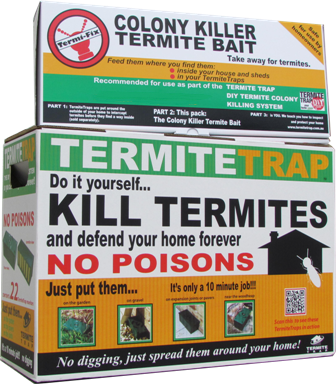
Termite Trap 1:1 Kit
Created for Australian conditions by Entomologist, TAFE lecturer and pest control textbook author Ion Staunton. It uses a system of bait and monitors – the same strategy that professional pest controllers will use. It takes 10 minutes to set up and lasts for years.
22 Traps and a Carton of Bait Pouches
$710Free postage in Australia

Tuckerbag Termite Baits
Registered for homeowner use by the APVMA in Canberra, use these baits to kill the whole colony and remove the termite threat. Deadly to termites but 100% non toxic to you, your family and pets. What you don’t use will keep for many years. Enough in a carton to kill a large colony or a couple of smaller colonies.
6 Termite Tuckerbags
$260Free postage in Australia

Pack of Termite Traps
You can buy the traps on their own and bait later when you need it. Place them on your garden, on pavers, over expansion joints about 3 metres apart. No digging. There are 22 in a carton; putting them around is a 15 minute job. Easy to check as you walk past and easy to add bait when required.
22 Traps
$475Free postage in Australia
Additional Information
You can download our free How-to-Guide
Check out the rest of our website and shop
OR speak to a friendly, helpful human… 1800 20 30 20
OR click here to open a chat
Questions & Answers
What kills termites instantly?
How do I get rid of white ants?
How do you get rid of white ants in the house?
What is the best treatment for white ants?
White ants are bad news
When the First Fleeters unloaded their stores on the shore of Sydney Harbour, the white ants were waiting and couldn’t believe their good fortune!
For millions of years they’d been eating fallen logs and branches of the eucalypts and other native hardwood trees and you can imagine the white ant ‘bush telegraph’ spreading the good news that suddenly there were pine crates, pine planks, oak barrels, etc — all softer and tastier — and placed conveniently on the ground.
Being sneaky, the white ants didn’t let on they were loving this new, soft timber and, as usual, they ate out the crates and barrels without any signs visible to passers by.The criteria for good or bad news depends on your viewpoint; termites thought it was good, humans thought it was bad and were perplexed to find thousands of scurrying “white ants” running for cover whenever wooden boxes of stores were shifted only to fall apart in the hands of the convicts doing the lifting.
There are no termites in Mother England but there are ants. These looked like white ants — a name which has stuck, even if ‘termites’ is preferred by those who wish to be seen as educated or at least, more precise.
We’re a talented group of creative individuals interested in art, cinematography, design, music, and all niches in between. Get to know us and what we can do for you!
Nesting habits
White ants come in many shapes and have differing habits. There are over 300 species in Australia but only a few do any significant damage to seasoned wood used to construct buildings. The subterranean termites base themselves in soil, access to a constant source of moisture which they absolutely need because of their thin outer shells.
The major pest termites hide their nests underground or inside hollow trees and prefer to eat solid, seasoned timber. Some mound-building species also eat solid timber, but because mounds are very visible, we just physically destroy the mounds so these white ants don’t get to inflict expensive damage. Many of the mound-builders, including those giant north/south, or so called magnetic mounds, are the homes of termites which eat grass and leaf litter. Termites from the brown to black nests seen way up in the branches of trees are seldom found eating solid wood unless it is decaying (which means it is not really solid).
Food finding
Grass and leaflitter eaters have it easy.
They often build ‘mud’ tunnels over the soil surface to a grass tussock and bring it back to their mound nest. They often scout ahead, walking along the ground before they build their tunnel along a pheromone trail left by the returning scouts. It is generally believed that the important subterranean species send their scouts out tunneling beneath the soil surface until they bump into something worth eating. On the scouts’ return, a “committee meeting” is convened and a decision is made whether the find is big enough to mount a construction team to build the underground tunnel to the newly found food source.
This scenario makes sense when they find and attack timber such as dead trees, or now, in civilized times, fence or other posts. Laboratory trials have proven this underground search methodology.
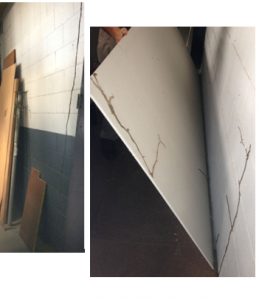
But they also scout above ground, right out in the open, just like their grass eating cousins.
How else would white ants find timber in wooden floors suspended on concrete or brick piers? Or to the paper on the plasterboard on the next floor, 3 meters up a painted masonry wall as shown in these photos.
Or from the mezzanine floor of the Sydney Town Hall, a 40-50 metre climb up painted walls and sandstone columns to the timber beams suspending the giant hour bell in the clock tower back in 1957. Learn more: The Book on Termites.

Reproduction and swarming time
As a starting point, the eggs laid by the queen are gathered by workers and stacked loosely in open cavities next to the royal chambers. When they hatch as white nymphs, they are moved a little further away from the queen to other cavities where food is brought to them from the outer reaches of the colony by workers who regurgitate it for their sustenance. As the nymphs get larger through a series of moults, they move further and further out and may even be found in food gathering sites close to the nest. In their last moults they become either workers or soldiers.
Workers are accurately named; they do everything — food gathering, nest building, maintenance, feed everyone (royals, nymphs, soldiers). Soldiers just swan around hoping not to get a call to action but when a tunnel or a working gallery is breached, they rush to guard the opening until the workers can repair it. If home owners discover white ants in their homes, the usual (and wrong) response is to rip it all apart to see how extensive is the damage. There is no hope of the termites repairing such wholesale destruction, so they set their defense line at a narrow area of their gallery closer to the nest. Those soldiers and workers cut off beyond “the pass” are sacrificed and die of dehydration (or in ‘hand to hand’ combat with ants, or from household sprays) but the colony survives and lives to suss out a new way around to keep on feeding.
After the nest is established about 2-5 years, young reproductive nymphs begin to appear. They have longer abdomens to contain the reproductive organs and you can see wings beginning to develop — and eyes. Neither workers or soldiers have eyes (which makes above ground foraging exploits even more meritorious).
Timing is everything. In early summer the workers open a slot cut in the highest areas of their feeding galleries.
The soldiers guard the slot, then one warm humid evening when the outside conditions closely match the inside temperature and humidity, maybe just after a storm or rain, when it is not windy and it is dusk, someone yells out “Geronimo!” and ten thousand teenage reproductives think it is schoolies and jump out into their unknown destinies.
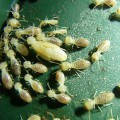
Being dark, most birds are gone for the day, most ants and lizards likewise. Not being strong on their wings, they flutter to stay airborne, drifting on any air currents there may be until they reach ground level. Boys find and follow girls and begin to search for a suitable place to build a nest. Usually it is a piece of wood in or on the ground. The critical requirement is the combination of food and moisture. Not one or the other but both.
They then lever off their equal sized wings because, after all, they are not strong enough to lift off again. They begin to excavate a pocket in the damp soil up against the wood they’ve found so that by morning when the first ants and birds are looking to ‘find the early worms’ they do not in any way wish to qualify.
Of the thousands that flew the colonizing flight, most won’t find a suitable site. The ants get them or they desiccate and die. Most of those that survive that first few days find they’ve picked a bit of wood in shallow soil that dries out. Food but no moisture is fatal. The lucky ones find the elusive combination and survive long enough to raise their first brood of eggs up to become workers which then help to build maintain and feed the group.
Survival is still some way off; the wood may be small and before food runs out, workers begin the search for another piece of wood, then another, and, they probably need to dig deeper to reach permanently damp soil. The central nest also needs to get further below the surface away from the heat. There’s plenty to do. This gives you some reasons why we are not totally overrun by termites.
It also explains in part why termites find our homes and try to recycle them as they would a fallen log or a dead tree in their prehistoric times.
Get Ion’s monthly “Tips on Termites”
A FREE PDF DELIVERED TO YOUR EMAIL
- Learn tips and advice from Australia’s #1 authority on termites. Ion Staunton is an entomologist, former pest technician and TAFE teacher.
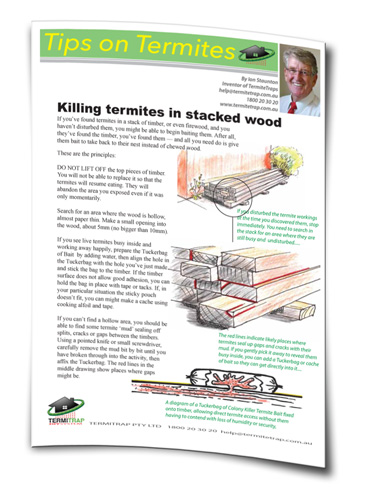
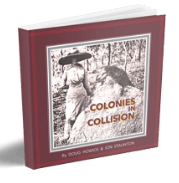

Im on a horse stud and have white ants eating my fences? is your prduct for my type os use, we are around 500acres of post and rail fencing. They are not everywhere but are eating certain areas??
Hello Mick,
You can see from Rhonda’s comments two above that the bait works when placed on an infested post. I’d love to sell you a pallet of Traps for lots of money but I have a couple of more reasonable suggestions:
1. physically destroy any mounds on your property. Some of the mound-building termites will eat solid timber such as fences.
2. you need to do some boundary riding to check you fences for tell-tale mud in joints or uneven surfaces that could indicate termites getting underway
3. if you find such attack, make a hole into the post or the mud in the joint and stick a Tuckerbag of bait over it so they can begin taking it back to kill the nest, wherever it is Just as Rohnda did
Hoping this helps, Ion